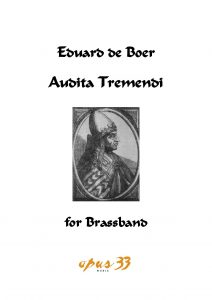
Audita Tremendi is the title of a papal bull issued by Pope Gregory VIII on October 29, 1187. It was written in response to the utter defeat of the Kingdom of Jerusalem at the Battle of Hattin on July the 4th of that year and the capture of the ‘True Cross’ (a piece of wood at the time believed to be from the cross upon which Jesus was crucified) by Saladin’s Muslim armies. Its title consists of the first two words of the text, which begins as follows:
Audita tremendi severitate iudicii, Having heard of the severity of the awesome judgment
quod super terram Hierusalem that over the land of Jerusalem
divina manus exercuit, the divine hand exercised,
tanto sumus nos et fratri nostri horrore confusi, by such a horror were we and our brothers disturbed,
tantisque afflicti doloribus, and afflicted by such sorrows,
ut non facile nobis occureret, quid agere, that it did not easily come to our minds what to do
aut quid facere deberemus, or what we should do,
nisi quod Psalmista deplorat et dicit: save that the Psalmist laments and says:
Deus, venerunt gentes in haereditatem tuam, ‘O God, the Gentiles have come unto your inheritance,
coinquinaverunt templum sanctum tuam; they have contaminated your holy temple,
posuerunt lerusalem in pomorum custodiam; they have laid waste Jerusalem;
carnes sanctorum tuorum they have left [the dead bodies of] your Saints as meat
bestiis terrae et escas volatilibus coeli etc. for the beasts of the earth and food for the birds of the air…’
[Ps. 78:1–2] [Ps. 78:1–2]
The bull is a passionate plea for a new crusade, and the eventual result became known as the Third Crusade, with Richard the Lionheart, Philip Augustus and Saladin as the most famous protagonists. The intensity of both the text and of the events that had preceded it and were to follow inspired me to dedicate a composition to this subject. It has become a composition in four continuous movements:
I. Turba (Turbulence)
The news that a large majority of Crusader forces was killed or captured during the Battle of Hattin results in chaos and turbulence, everywhere in Europe. This initially turns to grief.
II. Crucifigat Omnes (May all of them be crucified)
Now grief has turned to anger and lust for revenge. The Medieval song Crucifigat Omnes – part of the Carmina Burana collection – is an example of the atmosphere that pervaded Europe during the times of the Third Crusade. Here are the first and the last lines:
Crucifigat omnes May crucify them all
Domini crux altera, the Lord’s second cross,
nova Christi vulnera! Christ’s new wounds!
Arbor salutifera The Tree of Healing [‘True Cross’]
perditur; sepulcrum has gone lost. The grave
gens evertit extera has been destroyed by a foreign people
violente. Plena gente by force. Once full of people,
sola sedet civitas. the city now lies destitute.
(…) (…)
Suda martyr in agone Go sweat as a martyr in struggle,
spe mercedis et corone! in hope of reward and crown!
derelicta Babylone Leave behind Babylon
pugna and fight
pro celesti regione, for the heavenly region,
aqua vite! te compone for the water of life! Adjust yourself
pugna! by fighting!
The second time the melody of this song appears, it is merged with march-like music, that ultimately takes over, symbolizing a march all the way to the ‘Holy Land’. Finally, the port of Acre is reached and Saladin’s forces are awaiting the Crusaders.
III. Praelium (Battle)
Depicting the Battle of Acre, in October 1189, during which the Christian forces endured heavy losses, but which did not end in a decisive victory for any of the parties. The ensuing Siege of Acre lasted almost two years and was horror beyond imagination. Especially during the winter of 1190, where thousands of Christians died, due to lack of nutrition and large-scale epidemics:
IV. Hiemali Tempore (In Winter Time)
Scenes of mournful desolation alternate with music depicting gradually increasing frenzy. The melody from the medieval song Hiemali Tempore, also from the Carmina Burana collection, forms the basis of this movement. Towards the end, there is a ray of hope amidst all the sorrow and grief: a glimmer of hope that the day will come that there will be no more violence and hatred, both in the ‘Holy Land’ and elsewhere. But then frenzy takes over again, bringing the composition to an energetic conclusion.